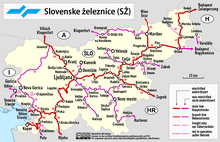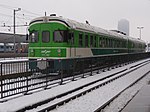Slovenske železnice
| Slovenian railways
|
|
|---|---|
| legal form | GmbH |
| founding | 1991 |
| Seat | Ljubljana , Slovenia |
| management | Dušan Mes |
| Branch | railroad |
| Website | slo-zeleznice.si |


Slovenske železnice ( SŽ ) [ slo'venske ʒe'leznitse ] ( German Slovenian Railways ) is the Slovenian state railway company.
history
The majority of the network was created at the time when a large part of Slovenia, as the Duchy of Carniola, belonged to the Austro-Hungarian monarchy . The most important of these routes was the Crown Prince Rudolf Railway from Vienna via Maribor and Ljubljana (Laibach) to Trieste . With the dissolution of the Austro-Hungarian monarchy after the First World War , most of what is now Slovenia fell to the SHS state ( Kingdom of Yugoslavia from 1929 ), and a western part to the Kingdom of Italy . The SHS state and Italy integrated the newly acquired route sections into their respective state railways, the railways of the Kingdom of Serbs, Croats and Slovenes (from 1929 Yugoslav State Railways JDŽ) and the Ferrovie dello Stato Italiane (FS). After the Second World War , Italy had to cede the area of Istria taken over from Austria after the First World War - except for the city of Trieste and a narrow strip of land along the Adriatic Sea - to Yugoslavia .
The railway lines were now operated by the JDŽ / JŽ. The most important new railway construction project at that time was the Prešnica – Koper railway line (31.5 km), which was opened in 1967 and connects the port of Koper with the railway network in the hinterland. Since it has steep gradients, re-routing is being considered.
When Yugoslavia disintegrated in the early 1990s , the individual states that became independent each formed their own state railway. Slovenia founded Slovenske železnice (SŽ) in 1991 from the holdings of the Ljubljana Directorate. The SŽ have been a member of the UIC since June 10, 1992 . Another consequence of the disintegration of Yugoslavia was that two branch lines that led to Croatia were shut down for cross-border traffic. On the other hand, the Ormož – Zalalövő ( Hungary ) railway line , which had previously been closed across borders, was put back into operation to create a connection that bypasses Croatia.
The Slovenske železnice were converted into a state-owned holding company on September 1, 2011 due to European law . Since then, the operational business has been the responsibility of the subsidiaries, which are wholly owned by the SŽ
- SŽ - Infrastruktura, doo (railway infrastructure),
- SŽ - Potniški promet, doo (passenger transport) and
- SŽ - Tovorni promet, doo (freight transport).
Infrastructure
The length of the Slovenian rail network is 1229 km with 128 stations, eleven of which are only for freight traffic . 504 km of the route network are electrified with 3000 volts direct current (as of 2004). The choice of this system stems from the fact that the first lines were electrified in the former Italian parts of Slovenia in 1942 and a system common in Italy was installed.
passenger traffic
Intercity traffic has been in operation since 2000, initially between Ljubljana and Maribor (part of the Spielfeld-Straß-Trieste railway line ). Pendolino trains of the SŽ series 310 , known as InterCity Slovenija (ICS) , also run between Maribor and Ljubljana . There are also individual connections to Koper .
vehicles
The SŽ fleet is very diverse and consists mainly of German, French and American license builds. There are also electric locomotives of Italian design, such as B. the series 342 and 362 . The SŽ also has 30 electric motor coaches of the Siemens Desiro type , which were purchased in 2000–2002 and are called the SŽ series 312 .
SŽ 711, still in the old paintwork from the time of the Yugoslav Railways , 2013
literature
- Railway Atlas Italy and Slovenia / Atlante ferroviario d'Italia e Slovenia . Schweers + Wall 2010. ISBN 978-3-89494-129-1
Web links
- Official website (English, Slovenian)







